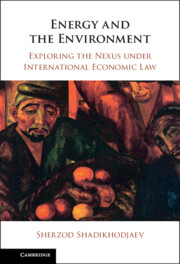Book contents
- Energy and the Environment
- Energy and the Environment
- Copyright page
- Dedication
- Contents
- Figures
- Tables
- Table of Cases
- Table of Treaties
- Table of Other Legal Texts (and Drafts)
- Abbreviations
- Introduction
- 1 Foundations of the Energy–Environment Nexus and International Economic Law
- 2 Energy Trade Control and Environmental Protection
- 3 Energy Subsidies and the Environment
- 4 Pro-environmental Energy Standards and Trade
- 5 Energy Investment Regulation and the Environment
- 6 Energy and Green Technologies
- Conclusion
- Book part
- Bibliography
- Index
4 - Pro-environmental Energy Standards and Trade
Published online by Cambridge University Press: 30 April 2024
- Energy and the Environment
- Energy and the Environment
- Copyright page
- Dedication
- Contents
- Figures
- Tables
- Table of Cases
- Table of Treaties
- Table of Other Legal Texts (and Drafts)
- Abbreviations
- Introduction
- 1 Foundations of the Energy–Environment Nexus and International Economic Law
- 2 Energy Trade Control and Environmental Protection
- 3 Energy Subsidies and the Environment
- 4 Pro-environmental Energy Standards and Trade
- 5 Energy Investment Regulation and the Environment
- 6 Energy and Green Technologies
- Conclusion
- Book part
- Bibliography
- Index
Summary
This chapter examines trade rules and practices regarding technical standards on energy efficiency, carbon emissions and renewable energy. Such standards usually complement anti-pollution, decarbonization and subsidization measures discussed in the previous chapters. The active use and trade implications of these measures in the energy–environment context have intensified the pace of raising related trade concerns in the WTO. Often tensions arise because of regulatory divergence that stems from differences in domestic situations, conditions and preferences as reflected in national standardization policies. But the notion that regulatory convergence is important in cutting trade costs is widely recognized, with many jurisdictions being increasingly involved in regulatory cooperation. Clean energy products can be supplied together with the associated services. Yet international trade rules on service standards are nearly under-developed and lack substantive details, which gives leeway to national regulators. Besides ‘general’ markets, green goods and services find their use in the segment of government procurement where environmental aspects are made part of technical specifications.
Keywords
- Type
- Chapter
- Information
- Energy and the EnvironmentExploring the Nexus under International Economic Law, pp. 142 - 185Publisher: Cambridge University PressPrint publication year: 2024

